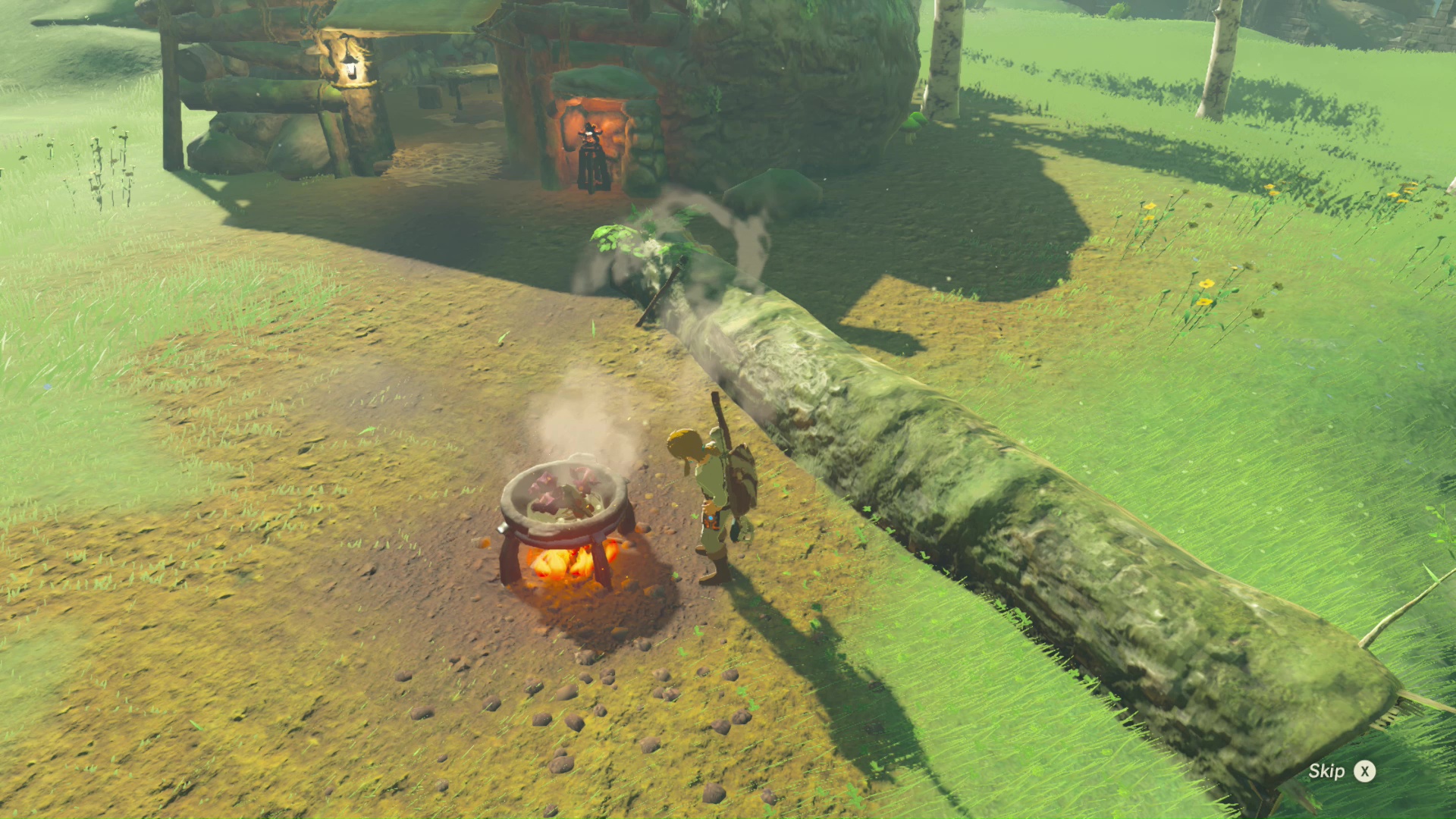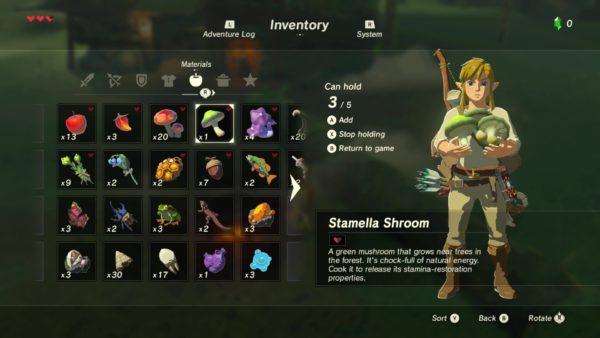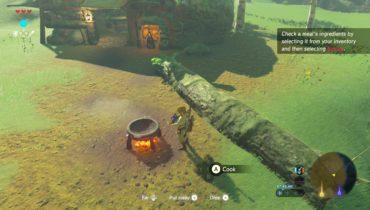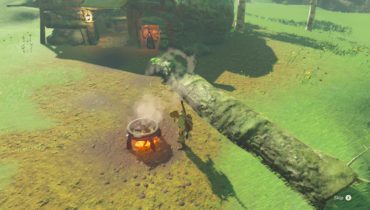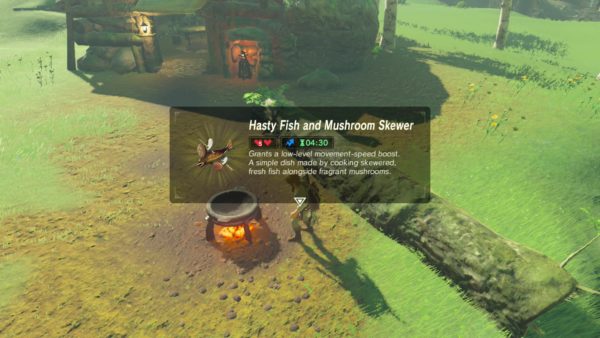The Legend of Zelda Breath of the Wild features a whole cooking system to allow players to create their own meals and elixirs using materials found in-game. Collect as many materials as possible and stock up on food before exploring or going into battle. A max of 60 cooked items can be added to the inventory at a time.
To cook food, you must first find a metal cooking dish above an open flame. These are found in each main town or at every stable. If the fire is not lit beneath the dish, throw a piece of flint near the wood and strike it with a metal weapon, or you can carry a flame using a torch from one fire to a stack of wood. Unfortunately, a fire isn’t possible while it’s raining, so wait out the storm by sleeping in a bed or doing something else with your time. With the fire and pan ready, go into your inventory and hold 2-5 different items from the materials section. Exit out of the inventory menu and drop the items into the pan to instantly create a meal or elixir that will be stored in the Food section of your inventory.
What’s the difference between a meal and elixirs? Meals are a cooked mixture of commonly found items such as fruit, vegetables, other plants, seafood, and raw meat. Elixirs are a cooked mixture of monster parts and critters (e.g. bugs, frogs, and lizards), but acorns and chickaloo tree nuts can also be added to elixirs. Mix materials from the food category with materials from the elixir category and you’ll get a censored dish of dubious food. It’s still edible, but has no special effects, is often terrible at restoring health, and no merchant will want to pay much for it while a great dish will get you hundreds of Rupees.
Additionally, some material can touch open flame, be exposed to cold climates, or get shocked by electricity and take on new properties. The material can either turn into a new type of material or become food and consumed without having to mix it with other items. Once a piece of material gets placed into the food category of your inventory, it cannot be mixed with other materials to make meals or elixirs.
Food Materials
The tables below list all the cooking effects for food material. Mix items with the same cooking effects to create great dishes. Placing items with different cooking effects together often negate them and simply restore health in the final meal.
A handful of materials are so great that they can be mixed with each other and still give you great meals. Mix five of the following materials with themselves: Mighty Bananas, Stamella Shrooms, Endura Carrots, Hearty Durian, Big Hearty Radish, Silent Shrooms, or Silent Princess
| Material | Hearts | Cooking Effects | Common Locations |
|---|---|---|---|
| Rock Salt | - | - | Merchants, Ore Deposits |
| Goron Spice | - | Cold Resistance | Goron Merchant |
| Goat Butter | - | - | Merchants |
| Cane Sugar | - | - | Merchants |
| Chikaloo Tree Nut | 0.25 | - | Merchants |
| Acorn | 0.25 | - | Hyrule Field, Squirrels |
| Fresh Milk | 0.5 | - | Merchants |
| Bird Egg | 1 | - | Merchants and Nests |
| Hylian Rice | 1 | - | Merchants |
| Tabantha Wheat | 1 | - | Merchants |
| Courser Bee Honey | 2 | Stamina Recovery | Hyrule Field, Tabantha Frontier |
| Raw Meat | 1 | - | Mammals |
| Raw Prime Meat | 1.5 | - | Mammals |
| Raw Gourmet Meat | 3 | - | Mammals |
| Raw Bird Thigh | 1.5 | - | Birds |
| Raw Bird Drumstick | 1 | - | Birds |
| Raw Whole Bird | 3 | - | Birds |
| Apple | 0.5 | - | Hyrule Field, East Necluda |
| Palm Fruit | 1 | - | East Necluda, Gerudo Desert |
| Wildberry | 0.5 | - | Gerudyy Highlands, Hebra Mountains |
| Hearty Durian | 3 | Extra Hearts | West Necluda, Faron Grasslands |
| Hydromelon | 0.5 | Heat Resistance | Gerudo Desert, Faron Grasslands |
| Spicy Pepper | 0.5 | Cold Resistance | Gerudo Desert, Tabantha Frontier |
| Voltfruit | 0.5 | Shock Resistance | Gerudo Desert, Gerudo Highlands |
| Fleet-Lotus Seeds | 0.5 | Speed Up | Lanayru Wetlands, Lanayru Great Spring |
| Mighty Bananas | 0.5 | Attack Up | Faron |
| Hylian Shroom | 0.5 | - | Hyrule Field, West Necluda |
| Endura Shroom | 1 | Extra Stamina | Hyrule Ridge, Hyrule Field |
| Stamella Shroom | 0.5 | Stamina Recovery | Hyrule Ridge, Hyrule Field |
| Hearty Truffle | 2 | Extra Hearts | Great Hyrule Forest, Hyrule Field |
| Big Hearty Truffle | 3 | Extra Hearts | Hebra Mountains, Great Hyrule Forest |
| Chillshroom | 0.5 | Heat Resistance | Hebra Mountains, Mount Lanayru |
| Sunshroom | 0.5 | Cold Resistance | Eldin Canyon, Gerudo Highlands |
| Zapshroom | 0.5 | Shock Resistance | Deep Akkala, Gerudo Highlands |
| Rushroom | 0.5 | Speed Up | Gerudo Highlands, Hyrule Ridge |
| Razorshroom | 0.5 | Attack Up | Great Hyrule Forest, Tabantha Frontier |
| Ironshroom | 0.5 | Defense Up | West Necluda, East Necluda |
| Silent Shroom | 0.5 | Stealth Up | Lanayru Great Spring, West Necluda |
| Hyrule Herb | 1 | - | Hyrule Field, Akkala Highlands |
| Hearty Radish | 2.5 | Extra Hearts | Hyrule Ridge, East Necluda |
| Big Hearty Radish | 4 | Extra Hearts | Akkala Highlands, Lanayru Great Spring |
| Cool Safflina | - | Heat Resistance | Hebra Mountains, Gerudo Highlands |
| Warm Safflina | - | Cold Resistance | Gerudo Desert, Hyrule Ridge |
| Electric Safflina | - | Shock Resistance | Gerudo Desert, Hyrule Ridge |
| Swift Carrot | 0.5 | Speed Up | Kakariko Village |
| Endura Carrot | 2 | Extra Samina | Hyrule Ridge, Faron Grasslands |
| Fortified Pumpkin | 0.5 | Defense Up | Kakariko Village |
| Swift Violet | - | Speed Up | Gerudo Highlands, Hebra Mountains |
| Mighty Thistle | - | Attack Up | West Necluda, Faron Grasslands |
| Armoranth | - | Defense Up | Akkala Highlands, Hyrule Ridge |
| Blue Nightshade | - | Stealth Up | West Necluda, Lanayru Great Spring |
| Silent Princess | - | Stealth Up | Hyrule Ridge, West Necluda |
| Hyrule Bass | 1 | - | Hyrule Field, West Necluda |
| Hearty Bass | 2 | Extra Hearts | West Necluda, Akkala Highlands |
| Staminoka Bass | 1 | Stamina Recovery | Hyrule Field, West Necluda |
| Chillfin Trout | 1 | Heat Resistance | Tabantha Frontier, Hebra Mountains |
| Sizzlefin Trout | 1 | Cold Resistance | Eldin Canyon, Eldin Mountains |
| Voltfin Trout | 1 | Shock Resistance | Tabantha Frontier, Hyrule Ridge |
| Stealthfin Trout | 1 | Stealth Up | Great Hyrule Forest, Eldin Mountains |
| Mighty Carp | 1 | Attack Up | Akkala Highlands, Lanayru Great Spring |
| Armored Carp | 1 | Defense Up | Lanayru Great Spring, East Necluda |
| Sanke Carp | 1 | Extra Hearts | West Necluda |
| Mighty Porgy | 1 | Attack Up | Necluda Sea, Lanayru Sea |
| Armored Porgy | 1 | Defense Up | Necluda Sea, Lanayru Sea |
| Hearty Salmon | 4 | Extra Hearts | Tabantha Frontier, Hebra Mountains |
| Hearty Blueshell Snail | 3 | Extra Hearts | Lanayru Sea, Necluda Sea |
| Razorclaw Crab | 1 | Attack Up | Necluda Sea, East Necluda |
| Ironshell Crab | 1 | Defense Up | Necluda Sea, East Necluda |
| Bright-Eyed Crab | 1 | Stamina Recovery | Lanayru Great Spring, Eldin Canyon |
Elixir Materials
The tables below list all the cooking effects for elixir material. Mix at least one critter and one monster part to boost an elixir’s special effects or restorative properties based on the rarity of the monster part. If critters with different effects are put in the same dish, the result is often a censored plate of dubious food.
| Material | Rarity | Monsters |
|---|---|---|
| Bokoblin Horn | Common | Bokoblins |
| Bokoblin Fang | Common | Bokoblins |
| Bokoblin Guts | Uncommon | Bokoblins |
| Moblin Horn | Common | Moblins |
| Moblin Fang | Common | Moblins |
| Moblin Guts | Uncommon | Moblins |
| Lizalfos Horn | Common | Lizalfos |
| Lizalfos Talon | Common | Lizalfos |
| Lizalfos Tail | Uncommon | Lizalfos |
| Icy Lizalfos Tail | Rare | Ice-Breath Lizalfos |
| Red Lizalfos Tail | Rare | Fire-Breath Lizalfos |
| Yellow Lizalfos Tail | Rare | Electric Lizalfos |
| Lynel Horn | Rare | Lynel |
| Lynel Hoof | Rare | Lynel |
| Lynel Guts | Very Rare | Lynel |
| Chuchu Jelly | Common | Chuchu |
| Red Chuchu Jelly | Uncommon | Chuchu + Fire |
| White Chuchu Jelly | Uncommon | Chuchu + Ice |
| Yellow Chuchu Jelly | Uncommon | Chuchu + Electricity |
| Keese Wing | Common | Keese |
| Fire Keese Wing | Uncommon | Fire Keese |
| Ice Keese Wing | Uncommon | Ice Keese |
| Electric Keese Wing | Uncommon | Electric Keese |
| Keese Eyeball | Uncommon | All Keese |
| Octorok Eyeball | Uncommon | Octorok |
| Octorok Tentacle | Uncommon | Octorok |
| Octo Balloon | Common | Octorok |
| Hinox Toenail | Rare | Hinox |
| Hinox Tooth | Rare | Hinox |
| Hinox Guts | Very Rare | Hinox |
| Molduga Fin | Rare | Molduga |
| Molduga Guts | Very Rare | Molduga |
| Material | Cooking Effects | Common Locations |
|---|---|---|
| Winterwing Butterfly | Heat Resistance | Hyrule Ridge, Tabantha Frontier |
| Summerwing Butterfly | Cold Resistance | Great Hyrule Forest, Eldin Mountains |
| Thunderwing Butterfly | Shock Resistance | Hyrule Ridge, Gerudo Highlands |
| Smotherwing Butterfly | Flame Guard | Eldin Canyon, Death Mountain |
| Cold Darner | Heat Resistance | Tabantha Frontier, Hyrule Ridge |
| Warm Darner | Cold Resistance | Akkala Highlands, Hyrule Field |
| Electric Darner | Shock Resistance | Hyrule Ridge, Gerudo Desert |
| Restless Cricket | Stamina Recovery | Hyrule Field, East Necluda |
| Bladed Rhino Beetle | Attack Up | West Necluda, East Necluda |
| Rugged Rhino Beetle | Defense Up | Hyrule Field, Faron Grasslands |
| Energetic Rhino Beetle | Stamina Recovery | Akkala Highlands, West Necluda |
| Sunset Firefly | Stealth Up | West Necluda, Great Hyrule Forest |
| Hot-Footed Frog | Speed Up | Lanayru Great Spring, Hyrule Ridge |
| Tireless Frog | Extra Stamina | Lanayru Great Spring, Hyrule Ridge |
| Hightail Lizard | Speed Up | West Necluda, East Necluda |
| Hearty Lizard | Extra Hearts | Gerudo Desert, Necluda Sea |
| Fireproof Lizard | Flame Guard | Eldin Canyon, Death Mountain |
| Fairy | Revives Link and restores 4 Hearts | Fairy Fountains |

